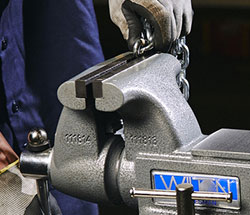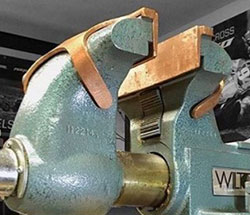About Wilton Tools


Holding Strong Since 1941
The legend of Wilton begins in 1941, when Hugh W. Vogl, a Czech immigrant, founded the vise manufacturing company naming it after the cross street where the original company building was located: Wilton Avenue and Wrightwood Avenue in Chicago, IL.
Hugh Vogl designed a 4-inch vise with a unique patented bullet design known at the time as the 40S Machinist Vise. The fine threaded spindle accurately fit in a horizontal anchored, unbreakable malleable nut. This created an even, central pull, which eliminated dead motion and unnatural strain on the nut. The thread on this vise was completely enclosed keeping it clean from contaminates and well lubricated for years of smooth operation. The steel key built into the base of the main body guides the movable jaw in a precisely broached keyway that is machined to .002” tolerances and eliminates wear, preventing side twists regardless of pressure exerted.
From 1941 through 1945, the new Wilton 40S machinist vise was manufactured in Chicago and sold solely to the US Government. Most vises were used in munitions factories or in manufacturing of equipment used during WWII.
After the war ended, the government dumped its surplus of tools and equipment into the marketplace at huge discounts. Because Wilton vises were only sold to the government and did not have a distribution network in place, the surplus of vises now flooded the marketplace from the government, and nearly forced Wilton out of business.
Hugh Vogl, together with his son Alex who began working with his father in 1951, set out to build a solid distribution network. They decided to start with the automotive supply distribution network which was on the post-war rise. Simultaneously, they decided it was time to expand the Wilton product line. In 1950, the 540 light-duty carriage clamps and 900 series heavy-duty machinist clamps were added to the line. These clamps were tested to deliver the maximum possible strength for each one of weight with a body made of refined malleable pearlitic castings with tensile strength ranging as high as 80,000 lbs psi. With spindles machined from high-quality cold rolled steel stock and fitted with generously proportioned handles all sizes were equipped with modern precision cut acme threads.
Wilton Tool Manufacturing stayed at the Chicago location until 1957 when they transitioned to the suburban Schiller Park, Illinois on Irving Park Rd just west of River Rd. The vises were cast with either the Chicago or Schiller Park locations which are one way to best determine the production date and location of the vise stamped with month/year on the keyway.
Later in 1952, with the assistance of Bill Ferrick and Charles Vogl grandson of the original owner, Wilton branched out into the industrial distribution network. By 1960, Wilton had become the recognized and accepted brand name in the marketplace, and by 1965 Wilton had become the preferred vise brand sold in the industrial market.
In the late 1950s, Wilton added the POW-R-ARM work positioners to their product line. This was a modern method to position bench work and speed up assembly lines. The Wilton Pow-R-Arm held the assembly or workpiece permitting the operator to have both hands free helping the operator to not only work faster but with greater accuracy and without exertion. The work positioners were available in either mechanical or hydraulic versions in multiple sizes and with several accessory attachments for all types of manufacturing operations. In 1960s, Wilton continued the expansion efforts adding hydraulic clamps and milling machine vises.
In the 1970s, Wilton discovered the retail market needed a quality vise line and opened an additional manufacturing facility in Winchester, TN for the production of smaller less expensive vises to meet the needs of the hobbyist and DIYer. Simultaneously in the Winchester facility, Wilton began manufacturing a metalworking machinery line. The first products in this category were drill presses and bandsaws.
In the effort to continue the takeover of the retail vise market, Wilton acquired the Warren Tool Group in the late 1990s. With facilities now in three states across the country, Wilton had managed to corner the entire vise market. The Columbian Vise, manufactured in Cleveland, OH was the other "Made In USA" vise and was included in the Warren Tool Company merger.
In 2002, the Wilton Tool Company and its recent merger company, Warren Tool were acquired by WMH Tool Group (Walter Meier Holding Company AG).
The manufacturing of the Wilton industrial vises was moved from Schiller Park to Carpentersville IL where the Wilton brand was brought into a family of quality brands recently acquired by WMH Tool Group. Those brands included JET Woodworking and Metalworking and Powermatic Woodworking which became a new house of brands.
In 2008, Walter Meier brands, JET, Powermatic and Wilton consolidated and relocated their offices to Lavergne TN outside of Nashville from Elgin, IL. They continued to grow and survive through a very difficult financial environment.
In 2014, Tenex Capital Management New York City, NY acquired the JET, Powermatic and Wilton brands from Walter Meier and changed the company name to JPW Industries where they continue to grow and outperform their competition with innovative, quality products and services.
Throughout all the changes over 73 years, the original bullet vise designed in 1941 by Hugh Vogl is still the largest-selling industrial vise in the marketplace.
That's the meaning of Holding Strong Since 1941.



